上海新教材牛津英语高一上学期英语教案
牛津上海版高中一年级第一学期Unit3教案
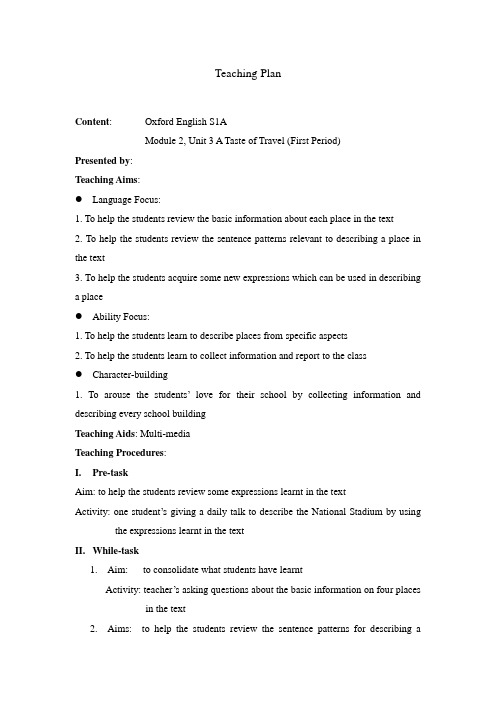
Teaching PlanContent: Oxford English S1AModule 2, Unit 3 A Taste of Travel (First Period)Presented by:Teaching Aims:●Language Focus:1. To help the students review the basic information about each place in the text2. To help the students review the sentence patterns relevant to describing a place in the text3. To help the students acquire some new expressions which can be used in describinga place●Ability Focus:1. To help the students learn to describe places from specific aspects2. To help the students learn to collect information and report to the class●Character-building1. To arouse the students’love for their school by collecting information and describing every school buildingTeaching Aids: Multi-mediaTeaching Procedures:I.Pre-taskAim: to help the students review some expressions learnt in the textActivity: one student’s giving a daily talk to describe the National Stadium by using the expressions learnt in the textII.While-task1.Aim: to consolidate what students have learntActivity: teacher’s asking questions about the basic information on four places in the text2.Aims: to help the students review the sentence patterns for describing aplace in the text and help them acquire some new expressionsActivities: 1) Locationa. students’ finding the expressions relevant to describing the locationof the places in the textb. teacher’s giving other expressions used to describe the locationof a placec. students’ using the above expressions to describe the location of theShanghaiMuseum which hasn’t been mentioned in the text2) Construction & Completion Timea. students’finding the expressions relevant to describing the time ofconstruction and completion time in the textb. teacher’s giving other expressions used to describe the constructionand completion timec. students’using the above expressions to describe the constructionand completion time of our school by using the given numbers3) Featuresa. students’finding the expressions used to describe the features ofthe four places in the textb. teacher’s giving another expression used to describe featuresc. students’describing the features of two pictures given by theteacher4) Activitiesa. students’finding the expressions used to describe the activitiesalong the Li River5) Visiting Timea. students’ finding the expressions about the visiting time in the textb. teacher’s asking the visiting time about our school libraryIII.Post-taskAim: to help the students consolidate how to describe a place by referring to its location, construction, features, activities and visiting timeOur school has established a friendly relationship with a French school for many years and every year some French students come to Shanghai for 5-day trip to visit our school and our country. As students whose second foreign language is French, we, students of Class Five are obliged to act as their tour guides to show them around our school and Shanghai.Activities: having a group discussion, four students a group1. students’ giving a general description of their school by using thegiven hints2. students’ giving a detailed description of every school building IV.Homework:Design the following four days’ travel arrangement for French students to visit Shanghai for sightseeing, shopping, knowledge and food。
牛津上海版高一英语上册同步教案 第1讲 句子成分与句子结构分析
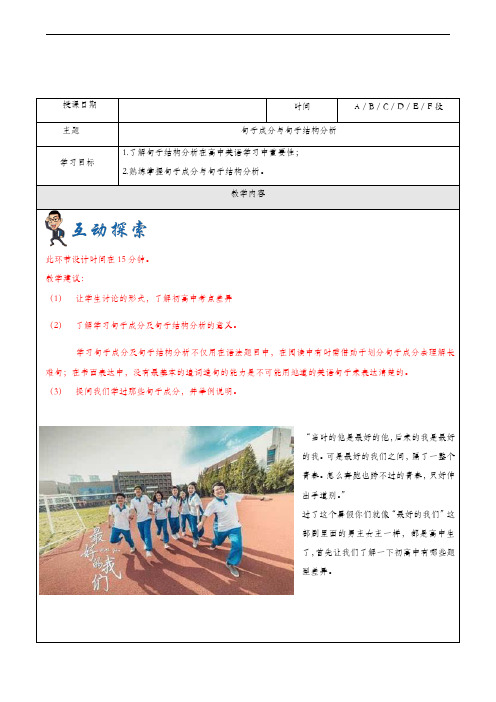
练习:指出下列句子中主语的中心词 1.The teacher with two of his students is walking into the classroom. 2.There is an old man coming here. 3.The useful dictionary was given by my mother last year. 4.To do today's homework without the teacher's help is very difficult.
From Yanan to Nanniwan was a three-hour ride on horseback. 从延安到南泥湾要三个小时。 11.从句用作主语。 如: Whenever you are ready will be fine. 你无论什么时候准备好都行。 Because Sally wants to leave doesn’t mean that we have to. 12.句子用作主语。
知识点 1:句子的成分 构成句子的基本成分叫做句子成分。句子成分可分为主语,谓语,宾语,表语,定语,状语,同位语。
它们可以由单词来担任,也可以由词组,以及句子来担任。 【知识梳理 1】 主语:指一个句子的主题,是句子所述说的主体。它一般位于句首。可用作主语的有单词、短语、从句乃至 句子。 1.名词用作主语。 如:A tree has fallen across the road. 一棵树倒下横在路上。 2.代词用作主语。 如:You’re not far wrong. 你差不多对了。 3.数词用作主语。 如:Three is enough. 三个就够了。 Four from seven leaves three. 7 减 4 余 3。 4.名词化的形容词用作主语。
牛津上海版高中一年级第一学期Unit3(第1课时)教案
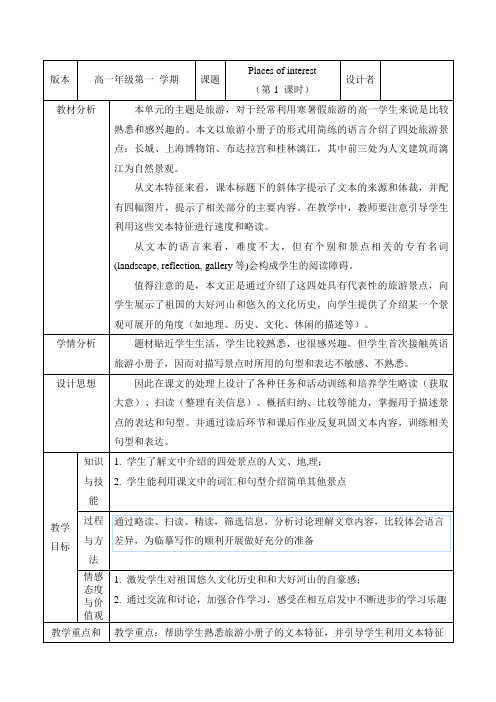
版本高一年级第一学期课题Places of interest(第1 课时)设计者教材分析本单元的主题是旅游,对于经常利用寒暑假旅游的高一学生来说是比较熟悉和感兴趣的。
本文以旅游小册子的形式用简练的语言介绍了四处旅游景点:长城、上海博物馆、布达拉宫和桂林漓江,其中前三处为人文建筑而漓江为自然景观。
从文本特征来看,课本标题下的斜体字提示了文本的来源和体裁,并配有四幅图片,提示了相关部分的主要内容。
在教学中,教师要注意引导学生利用这些文本特征进行速度和略读。
从文本的语言来看,难度不大,但有个别和景点相关的专有名词(landscape, reflection, gallery等)会构成学生的阅读障碍。
值得注意的是,本文正是通过介绍了这四处具有代表性的旅游景点,向学生展示了祖国的大好河山和悠久的文化历史,向学生提供了介绍某一个景观可展开的角度(如地理、历史、文化、休闲的描述等)。
学情分析题材贴近学生生活,学生比较熟悉,也很感兴趣。
但学生首次接触英语旅游小册子,因而对描写景点时所用的句型和表达不敏感、不熟悉。
设计思想因此在课文的处理上设计了各种任务和活动训练和培养学生略读(获取大意)、扫读(整理有关信息)、概括归纳、比较等能力,掌握用于描述景点的表达和句型。
并通过读后环节和课后作业反复巩固文本内容,训练相关句型和表达。
教学目标知识与技能1. 学生了解文中介绍的四处景点的人文、地理;2. 学生能利用课文中的词汇和句型介绍简单其他景点过程与方法通过略读、扫读、精读,筛选信息,分析讨论理解文章内容,比较体会语言差异,为临摹写作的顺利开展做好充分的准备情感态度与价值观1. 激发学生对祖国悠久文化历史和和大好河山的自豪感;2. 通过交流和讨论,加强合作学习,感受在相互启发中不断进步的学习乐趣教学重点和教学重点:帮助学生熟悉旅游小册子的文本特征,并引导学生利用文本特征板书设计landscapeplace of interestreflectiongallery…。
上海牛津版英语高一第一学期完整版

上海牛津版英语高一第一学期HEN system office room 【HEN16H-HENS2AHENS8Q8-HENH1688】上海牛津版英语高一第一学期language-grammarLanguage一、章节分析(一)综述本章节主要语法---动名词在牛津英语中出现两次: 本课和高二(下)第一课。
本课主要介绍动名词作主语、动词宾语、介词宾语;高二(下)第一课主要介绍一些动词后接动名词和不定式的区别。
故本课不仅要介绍课本上动名词的基本用法,还应扩展动名词作真正主语用法,总结后接动名词作宾语的动词,归纳带介词to的动词短语,但不应挖得太深。
(二)目标学习动名词作主语、动词宾语、介词宾语和表语的基本用法。
(三)教学方法口语情景教学法( 教师创设情景,学生主要通过口语训练达到对语言知识的掌握)(四)重点和难点1A部分简单总结一些不含冠词的介词短语2B部分要细讲3C部分省略不讲二、教学设计(Teaching Designs)《牛津英语一让学生找出课文中含有动词-ing的句子,分析比较它们的不同点,引出正题:动名词。
介绍动名词的特点。
教师先利用图片举例,介绍动名词作主语用法,然后在ppt的辅助下通过图片,提示词,学生小组练习。
动名词作动词宾语,介词宾语等讲法同上。
[具体处《牛津英语教理这部分内容的建议见[衔接1;课件:gerund]拓展动名词作真正主语用法,总结带动名词作宾语的动词,归纳带介词to的动词短语。
[具体处理拓展部分内容的建议见[衔接2]。
学生写一段话,尽量多用刚学的动名词;学生做一些教师精选的单项选择,以便巩固所学语法。
[具体处理这部分内容的建议见[衔接3]。
1Ask students to find the sentences which have the form of v.+ing in the text .(possible answers):He gave an encouraging smile.Communicating is more than speaking and listening.She is holding her head up.2Explain the meaning and features of gerunds.Gerunds are –ing nouns. It is a kind of nouns. So in the abovesentences, only “communicating, speaking, and listening” are gerunds.As a noun, gerunds can be used as subject, verb object, prepositionobject, predicative and attributive.Step Two Presentation1Gerunds as subjects1)Example:T: What does shaking hands mean?S1: Shaking hands is a sign of friendship.S2: Shaking hands means that you are friendly.(动名词作主语时,位于动词用单数)2)PracticeStudents practise according to the example. They work in pairs. S1makes questions using the pictures and turning the verbs inbrackets into –ing nouns. S2 chooses answers from the box.Shaking your fist is a sign of anger.Sighing is a sign of sadness.Yawning means that you are sleepy.Closing your eyes means that you are thinking.Whistling means that you are happy.Scratching your head means that you are thinking.Bowing is a sign of respect.(补充讲解句型It is (was) no use/good doing something.)2Gerund as verb objects1)Example:T: I didn’t know you could swim.S: Didn’t you I love/ like swimming.T: So do I. I really enjoy swimming.I don’t. I hate / dislike swimming.I prefer walking.2)Practice:Students work in pairs to make similar dialogues about thepictures. Follow the example.3)Tell students some other verbs which have such usages.admit, appreciate, avoid, be worth, complete, finish, deny, delay,postpone, escape, practice, suggest, miss, allow, permit, forbid,consider, imagine3Gerunds after prepositionsOn her first day at work, Debbie saw the things. She didn’t know what they were for, so she asked Mr Yang.Work in pairs to complete their conversation. S2 should answer S1,using –ing nouns made from the verbs in the box along with“for”.1)Example:T: Excuse me, but what are these _keys_____ for?S: They’re _for____ __locking_____ the drawers of the desk.2)Practice:Students work in pairs to make similar dialogues about thepictures. Follow the example.S1: And this _______S2: It’s _______ ________ letters.S1: What about these _______ ________S2: They’re _______ ________ your paper together.S1: This ________. What’s it for?S2: It’s _______ _______ the dates on documents.S1: And these ________S2: They’re _______ ________. They’re a present for your firstday at work.( 补充总结含介词to的动词短语:be (get)used to, get down to, lookforward to, lead to, payattention to, be devoted to, object to例如:Let’s get down to talking about your future.I’m look forward to hearing from you.)(见课件:gerund)[链接2]13)It’s worth doing…4)…can’t help doing…〖典型例句〗1)It’s no use crying over the spilt milk.2)The place is well worth visiting again.3)There is no point cheating in the exam.4)We can’t help laughing at the joke.5)It’s no good copying others’ homework.2下列动词后常接动名词做宾语1)admit, appreciate, avoid2)complete, consider3)delay, deny4)endure/stand, enjoy, escape, excuse5)finish6)imagine7)keep8)mind, miss9)postpone, practice10)resist, risk11)suggest巧记这些动词的诀窍:继续坚持勿停止;盼望完成莫推迟错过成功会后悔;惯于冒险须放弃避免原谅不逃脱;忙于欣赏禁不住介意练习很值得;考虑建议末延迟想象无用已无益;记得做过勿忘记禁止使用不定式〖典型例句〗1)I enjoy reading books in bed though it is not a good habit.2)I can’t imagine going to any place without you.3)Would you mind opening the door for me?4)He suggests reading English every day.5)The bird missed being shot.6)He escaped being punished by running away.3下列动词短语种to为介词1)be (get)used to2)get down to3)look forward to4)pay attention to5)be devoted to6)object to7)lead to〖典型例句〗1)I used to get up late, but now I’m used to getting up early.2)After discussing with his deskmate, he got down to writing hiscomposition.3)I’m looking forward to hearing from you.以下几点可以在以后单元里讲解:1)need/ want / require 句型2)love, like, hate 后接 to do 与doing 作宾语的区别3)stop, remember, regret, try, mean, go on, forget后接 to do 与doing作宾语的区别4)allow, permit, consider, advise后接 to do 与doing 作宾语和宾补的区别5)动名词的时态和语态6)动名词的复合结构[链接3]1.Do keeping _____, will you?A. to tryB. tryC. having triedD. trying2. We are all looking forward ______ Mr. Smith next week.A. to seeB. of seeingC. at seeingD. to seeing3. He spent all his time ______ for the final examination.A. to prepareB. of preparingC. in preparingD. to preparing4. The boy is only five years old, but he is quite used _____ the telephone.A. to answerB. to answeringC. of answeringD. by answering 5. ______soundly is better for your illness than taking medicine.A. To sleepB. SleepingC. SleepD. Having slept6. Sometimes when I look into the sky, I feel like ______ a trip somewhere.A. to makeB. makingC. makeD. to go for7. I consider _____ of every fish is a kind of murder.A. takingB. a takingC. the takingD. to take8. My grandfather is a rich man, but ______ money does not solve all his problems.A. hasB. to haveC. havingD. having had9. It is no good ______ him to see you off.A. to expectB. expectingC. of expectingD. for him to expect 10.There is one more book worth ______.A. readB. of readingC. being readD. reading11.He liked ______ many questions at the press conference.A. being askedB. askingC. of askingD. ask12.We had no trouble ______ the path through the forest.A. to findB. for findingC. findingD. with findingII.用括号里的动词的正确形式填空:1. He insisted on _______(do )the work in some other way.2. The windows want / need / require to be cleaned. That is, they need /want / require _____ (clean).3. He practiced _______(play) the piano every day.4. She doesn’t mind ______( work ) overtime.5. It will mean ______( benefit ) your company and mine.6. Have you decided to put off ______( go ) to the seaside?7. Peter kept (on) ______ (ask) questions.8. It’s a waste of time ______( argue) about it.9. _____ ( talk ) is easier than doing.10. Have you finished _______ (do) your homework?III.翻译:1. ______(每天晨读一刻钟)is very important in learning English.2. It’s no use _______(叹气).3. Debbie enjoys _______(微笑着与客户交流).4. John has just given up ______(吸烟).5. I ______(一直盼望着访问)China again.6. He run off to avoid ______(看见)by his class teacher.7. This machine is for ______(切纸).8. This book is well worth ______(读).9. ______(挥动拳头)is a sign of anger.10. Mr. Yang suggested/advised ______ (看着顾客的眼睛)to make a good impression on him.IV.拓展题:1.---You were brave enough to raise objections at the meeting.---Well, now I regret _____that.A. to doB. to be doingC. to have doneD. having done2.The patient was warned _____ oily food after the operation.A. to eat notB. eating notC. not to eatD. not eating 3.She looks forward every spring to _____ the flower-lined garden.A. visitB. paying a visitC. walk inD. walking in4.The little time we have together we try _____ wisely.A. spending itB. to spend itC. to spendD. spending that 5.While shopping, people sometimes can’t help ______ into buying something they don’t really need.A. to persuadeB. persuading D. being persuaded D. be persuaded6.What worried the child most was ______ to visit his mother in the hospital.A. his not allowingB. his not being allowedC. his being not allowedD. having not been allowed7.Tony was very unhappy for _____ to the party.A. having not been invitedB. not having invitedC. having not invitedD. not having been invited8._____ to sunlight for too much time will do harm to one’s skin.A. ExposedB. Having exposedC. Being exposedD. After being exposed9.The discovery of new evidence led to _____.A. the thief having caughtB. catch the thiefC. the thief being caughtD. the thief to be caught10.One learns a language by making mistakes and _____ them.A. correctB. correctingC. correctsD. to correct11.---You should have thanked her before you left.---I meant _____, but when I was leaving I couldn’t find her anywhere.A. to doB. toC. doingD. doing12.In some parts of London, missing a bus means_____ for another hour.A. waitingB. to waitC. waitD. to be waiting13.---What’s made John so angry?---______ the tickets for the concert.A. LoseB. To loseC. Because of losingD. Losing14. The day we are looking forward to _______ at last.A. arrivingB. arriveC. arrived D. arrives15. Mr. Reed made up his mind to devote all he had to ____ some schools for poor children.A. set upB. setting upC. have set upD. having set up附答案:Ⅰ.单选:DDCBBBCCBDBCⅡ.用括号里的动词的正确形式填空:doing, cleaning, playing, working,benefiting,going, asking, arguing, Talking, doing Ⅲ.翻译:1.Reading for a quarter of an hour every morning2.sighingmunicating with customers with a smile4.smoking5.am looking forward to visiting6.being seen7.cutting up paper8.reading9.Shaking one’s fist10.looking at customers’ eyesⅣ.拓展题:DCDBD BDCCB BADCBChapter2. Care for hair-More Reading教案一、章节分析(Reading section)(一)阅读地位(Reading Position)1)more language input同样围绕着头发这个主题,但给学生提供了一些额外的相关信息。
高一牛津英语必修1全册教案

高一牛津英语必修1全册教案一、教材简介《牛津高中英语必修1》是牛津大学出版社为高中一年级学生编写的英语教材。
本教材共分为6个单元,涵盖了生活、学校、家庭、旅行等主题,内容丰富多样,语言实用性强,适合高中一年级学生的英语学习。
该教材注重培养学生的综合语言运用能力,通过听、说、读、写等多种方式进行教学,帮助学生提高英语综合能力。
二、教学目标1.通过本单元的学习,学生能够掌握一些基本的英语词汇和句型,并能在实际生活中熟练应用。
2.培养学生良好的听、说、读、写能力,提高学生的英语交际能力。
3.培养学生的自主学习能力和团队合作能力,发展学生的创造性思维和逻辑思维能力。
4.培养学生的文化意识和跨文化交际能力,提高学生的国际视野和文化素养。
三、教学重点1.单词和词组的掌握和运用。
2.句型的掌握和运用。
3.听力技巧的培养和提高。
四、教学内容与方法单元1:Unit 1 School Life教学内容:1.学习与学校生活相关的词汇,如classroom, teacher, student, desk等。
2.学习动词to be的用法,并练习句式结构。
3.学习一些日常用语和对话。
#### 教学方法:4.创设情境,引导学生通过图片和实物进行学习。
5.利用多媒体资源,辅助教学,激发学生的学习兴趣。
6.进行小组活动,提高学生的合作能力和语言表达能力。
单元2:Unit 2 Family Life教学内容:1.学习与家庭生活相关的词汇,如father, mother, brother, sister等。
2.学习表示“喜欢”和“讨厌”的表达方式,并运用到句子结构中。
3.学习描述家庭成员以及其职业的英语表达方式。
#### 教学方法:4.利用图片和实物,让学生感受到家庭的温馨和幸福。
5.分角色进行对话练习,培养学生的口语表达能力。
6.进行情景模拟活动,让学生在实际情境中运用所学知识。
单元3:Unit 3 Travel and Adventure教学内容:1.学习与旅行和冒险相关的词汇,如mountain, beach, explore, adventure等。
【高一】高一牛津英语必修1全册教案

【高一】高一牛津英语必修1全册教案Unit 1 School LifeWelcomeAims and requirements♦ Read a magazine article about school life in the U and two otherarticles about school clubs♦ Listen to a headmaster talking about school activities♦ Discuss daily school life with your class partner♦ Report your school activities to your class teacher♦ Write a notice about school activities♦ ake a poster for a new school clubprocedures●Welcome to the unitStep 1: BrainstormingIt’s the beginning of a new term. You have just finished junior high and are about to enter a new period in your studies. I am very happy to have all of you in my class and I hope we can be friends. I can see that some of you are eager to knohat studying at senior high will be like. Will it be different from junior high? Well, there are certainly many differences between junior high and senior high, but there are also some things that are the same in every school in China. What about schools in other countries? Do students learn differently and have different experiences? Are schools all over the world the same?This is the subject of our first unit. Today we are going to look at schools in the United ingdom and try to work out if they are the same or different from schools in China. Here are four pictures that show some aspectsof school life in the U. Please look at the pictures, read the instructions and try to determine the differences between schools in China and the U.Step 2: Discussing and practicingLet’s have a discussion for several minutes.(The teacher can use the following contents to help students.)Huge campus and low-rise buildings: In the United ingdom,we can see huge campus and low-rise buildings in this picture. It is the biggest difference from schools in China. Schools in China usually have a large enough campus to make sure students have enough space to study and play in. But most school buildings are taller, at least three storeys.Lockers for every student: In the United ingdom, there are rows of lockers by the classrooms for students to put their stationery, books, exercise-books and other belongings.In China students bring what they need for lessons to school and then take it all back home after school. ost schools in China do not have the equipment in the classroom.Fewer students in each class:In the United ingdom, there are fewer students in a class, no more than 30 per class.In China, There are usually more students in high school, perhaps 50 to 60 per class. Recently some schools are beginning to limit the number of students in each class.At ease with our teacher:In the United ingdom, students have a close relationship with their teachers. They feel at ease and comfortable with them.It is similar in China. Nowadays, lots of teachers and students have established a good relationship with each other. They respect each other and work to gain a better understanding of each other.Now try to combine your own school experiences with knowledge gained from this text and other sources, so that you can participate fully in the discussion.(Give students a couple of minutes to talk about the following three questions.)1. Do you know any other differences between the lives of Chinese and British high school students?2. What kind of school activities do you enjoy?3. What is your dream school life like?Now in groups exchange your opinions and everyone is supposed to speak out your idea. Each group will then report your conclusions to the whole class.Word powerBoys and girls, we have dealt with the differences and similarities about school life between China and U. I think you have had a better understanding of the reading material. Do you like your school life? Here are some pictures for you to appreciate.What can you see in the picture? Which aspect or factor attracts you most and causes you to study in our school?(beautiful night scene, teaching buildings and two marble statues. They reflect how beautiful our school is. We students in our school can be encouraged to study better and harder with such beautiful and meaningful surroundings)Today we will come to Word Power.This section deals with words and expressions related to school facilities. Familiarize yourselves with the school facilities and review expressions of asking and answering the way. Parts A and B involve activities that aim to activate your relative prior knowledge. Part C is designed to reinforce the vocabulary involved in Parts A and B. Part D aims to expand and evaluate your vocabulary by doing a matching exercise.You are not only to expand your related vocabulary but also to apply them in practical usage.Step 1: Brainstorming1. Thinking about the following topic:School plays an important part in children’s growing-up. When youfinished your junior study, your parents and you all had a careful and thoughtful consideration about which senior high school suited you best or which senior high school could give you the best education and provide the best environment. So can you tell me which aspect or factor attracts you most and causes you to study here? (The teacher encourages students to express genuinely about their choices.)2.Recalling the first day to schoolDo you still remember the first day you came to this school? How did you find your way around?Usually, if you don’t know your way, what will you do? Do you ask others for help? Now think about the patterns you learned in junior high.Excuse me, can you tell me the way to...?Excuse me, which is the nearest way to...?Excuse me, how can I get to/arrive at/reach... ?Turn right/left, and walk straight on.At the end of the first/second crossing, you will find it on yourright/left.You can’t miss it.Walk towards/pas t…and then walk between..., and you will find…at the end of the road.3. Dealing with the mapFocus on the map first and familiarize yourselves with each building. Now read Wei Hua’s thoughts carefully and mark her routes on the map. Pay attention to Wei Hua’s expressions and try to learn the usage of these phrases.Step2: Vocabulary learning1. Dealing with BDeal with Part B individually according to the instructions and write a description of the quickest way to get from the dormitories to Classroom 4. Then report your answers to the class.Sample answersIf you are standing at the door of the dormiories, first turn right and go past the medical centre and the gym, then turn left and walk until the end of the road. Classroom 4 is on your left.(If possible, the teacher can design some similar exercises to the one above for students to practise. For example, the teacher can ask students tomark the shortest way from the science laboratory to Classrooms 16-25. This exercise aims to help students to use proper expressions while finding the way.)2. Dealing with A and B for homeworkDeal with Part A on page 85 in Workbook. After reading the letter, youwill know how to write a note to indicate the way to somewhere. (Part B as homework)3. Dealing with CRead Part C and complete it. You’d better consult each other or the dictionary whenever you have a problem before consulting me. Then report your answers. Pay attention to your pronunciation and spelling.AnswersC. (1) car park (2) classrooms (3) library (4)labs (5)gym(6) swimming pool (7) dormitories (8) medical centre (9) canteen4. Dealing with DHave ever been to a gym? If not, try to imagine what kinds of equipment are usually provided in a gym and why gyms are popular nowadays.( a. The teacher can play some videos for students to watch and meanwhile teach them how to say these pieces of equipment in English. Then ask students to finish Part D.b. If possible, take students to a gym to have the lesson. While teaching, the teacher can invite students to do some performances on the equipment and meanwhile the teacher instructs students in English how to use this equipment.c. Ask students to discuss the following questions: Do you think having a gym is an important factor for students when choosing a school? Why are more and more key schools spending a large amount of money in improving their school facilities? Do you think it is necessary for all schools to have this kind of equipment?)AnswersD (4) beam (7) barbell (1) climbing bars (6) basketball court(2) rings (8) mat (3) dumb-bell (5) skipping ropeAnswers to Part B (page 93)Dear ickey,I came to see you but you happened to be out. I’d like to invite you to visit me at school when you hav e time. Here’s how to get to my dormitory.When you get to the school gate, you’ll see the playground in front of you with the gym on the left and three classroom buildings on the right. Go toward the gym. Then, walk along the road between the playground and the gym. Go straight ahead, pass the library and the teacher’s office until you reach a small river. Take a right turn to get to the bridge. After you cross the bridge, you’ll see three buildings ahead. The one in the middle is our canteen. The two buildings on either side of the canteen are the dormitories. The one on the left is Dorm 1.That’s where I live.See you soon.AndyResourcesSchool facilities are an important part of school construction and development. Sometimes, the school will allocate a large amount of funds for redecorating school buildings, buying new pieces of equipment and making the whole school environment safer and more pleasant. For more information, you can visit the following website:. 24hourfitness/html/fitness/ today/●Project Starting a new school clubEverybody, please look at a picture on the screen. Do you knohat the girl student is doing? (She is broadcasting.) Yes. Does your school have such a radio station/club? What does it often do usually?The project in this unit is designed to help you use English through doing a project. The two reading materials about school clubs here are samples for you to learn how to develop after-school activities and form a school club. Try to design a poster advertising a new school club.You’re supposed to use what you’ve learned to finish a project byworking together. You may discuss what club you’d like to start, and whateach of them will do. Search for some information, do some writing and drawing. To make an attractive poster, you are expected to cooperate to complete each part of the task.ARead the first passage about a school radio club run by students themselves. Find out as much information as you can about the radio club.Who started the radio club? (ate Jones, the writer)When was the radio club started? (two years ago)Why was the radio club started? (CD players were not allowed in school; to play music during break time)What does the radio club do? every morning: (tell about the weather, the recent news, special messages the teachers want to broadcast) during exam time: (the special programme telling students what they should and shouldn’t do) at the end of the school year: (graduating students giving messages to their friends and teachers) when parents come: (playing songs sung by students, special messages to inform people about events)Find out as much information as you can in the second passage about the school club.the name of the school club: (Poets of the Next Generation)Who started the school club? (r Owen, the English teacher)When do the members of the school club meet? (the last Friday of every month)What do the members of the school club do? (talk about poems and poetsthey like, select poems, read out aloud, write poems and read out)Choose the best answer according to the reading material.1. What was the school radio club started for at first?A. To inform teachers in school of important things.B. For playing music for everyone during break time.C. To broadcast special messages.D. For students to learn English by listening to radio.2. Which of the following is not included in the programmes of the school radio club?A. How to go on diets and keep slim.B. Special messages to students by teachers.C. Songs sung by students.D. Advice to students on preparations for exams.3.Which of the following statement is not right according to the project?A. The radio club can not only be helpful to students but also can keep parents informed of school events.B. I, as one of the club hosts, like the club very much.C. The club is much more than just music.D. Although I have graduated from school, yet I miss the club and often visit it.eys: BADWhat do you think about the two articles? Whether you would like to start a club to do something you’re interested in?Now let’s deal with Part B1 on page 87 in Workbook to know better how to use the useful phrases in the two passages.Read Part B2 on the same page to identify the different usages of talk, tell, speak, say and read.(To review the words and sentence patterns in this unit, you can do Parts D1 and D2 on page 89 in Workbook as your homework, and design a poster.)BEnjoy a poster, please.Two questions to answer.1. What does the poster consist of?2. How does it attract its viewers?PlanningWork in groups of four. Discuss and choose what school club you’d like to start in your class or school. Divide the tasks among group members. Fill in the blanks in this part.Preparingembers responsible for different tasks should make preparations and answer the questions in this part. Then you can meet, discuss and select from the information found.ProducingThose who are making the poster will draft the poster based on all the ideas from the group’s research and discussion. When the poster is finished, each group member should read it carefully and give suggestions to make it more attractive.PresentingNow time to present your posters to the whole class. Talking about your club and display your posters in the classroom so that other students choose which school club they would like to attend.AnswerPart B1 (p87)1 reads out 3 such as 5 is allowed to 7 gives to2 inform of 4 are required to 6 making preparations for 8 much more thanPart B2 (p87)1. talk 3. tell 5. said 7. say talked talked 9. read2. read spoke 4. speak 6. speak 8. toldPart D1 (p89)1. exciting 3. achieving 5. selected 7. attend2. prepare 4. clubs 6. Literature 8. experiencePart D2 (p89)1. I think the best way to protect the environment is to plant more trees.2. Going to the park for a picnic on the weekend sounds like a good idea.3. In summer holidays he spent most of his time surfing the Internet.4. The girl who used to be a model is now a famous actress.5. Talk to her more, and you will find that she isn’t as bad as you thought she was.6. As it was getting dark, I decided to find a place to stay.7. “Stop shouting! You are giving me a headache,” said mother angrily.8. Though it is difficult to improve your handwriting in such a short time, you should still keep practising.Part A (p90)1. It will help them feel like part of a group and also it will make the school’s sports teams feel proud.2. To gain knowledge.3. Because they are comfortable and do not need special care.4. He thinks they look very boring.5. No. He thinks that students could wear their leisure clothes outside of school.Part B (page 91)1. They have to pass the SATs, complete application forms and writeletters to the colleges.2. She can help students choose a good college.3. Because students do not study the same subjects.4. They might go to school early to use the Internet service and theymight stay late if theyhave after-school activities to go to.5. Participating in various after-school activities.●Task Reporting school activitiesAs we all know, there are various school activities for students to attend. What school activities do you often have? Can you name some? This section consists of a series of activities which provide you with opportunities to practise your language skills of listening, reading, speaking and writing. Itis divided into three steps, and each step is preceded with a skills building activity. Through the three steps, you will learn to solve a practical problem in your daily life--how to talk about school activities and how to write a notice about a school activity.Skills building 1: understanding a programmeSuppose you are monitor of a class and you are to plan and arrange a class meeting for parents to visit your school. What will be informed yourclassmates of about the class meeting? That is to say, what will be includedin your plan?Here you can find out what a programme usually includes when you read the guidelines and you will knohat you should notice when you are listening to someone talking about a programme.1. Read the five points in Skills building 1 on page 12. Write down the names of months and the seven days of a week in abbreviations. For example,2nd/2 Feb; 5th/5 ar; 3rd/3 Aug; 21st/21 Oct; 30th/30 Nov; on; Wed; Tue; Fri; Sat2. Listen to the tape and finish the timetable on page 12.TapescriptReporter: Good morning, r Gu. What’s your programme like for next week?Scientist: On the twenty-first of October, that’s onday, I will visityour school, Datong High School, at nine thirty in the morning, I will give a talk to the whole school. At a quarter to one in the afternoon on the twenty-second, I will attend an important school assembly at Guanghua High School,and I will go to the school concert at Xiangming High School at six p.m. onthe twenty-third.Reporter: Wo You are really busy. I look forward to seeing you again on onday.Answers:DateDayTimeVenueActivity21st Oct22nd Oct23rd OctonTueWed9:30 a.m.12:45 p.m.6:00 p.m.Datong High Schoolgive a talkattend an important school assemblygo to the school concertStep1: completing a timetable for a school programmeThis part is designed to help you develop your listening skills by listening to a talk given by the headmaster about a school programme. Complete the programme according to what the headmaster says. Identify the times, venues, subjects of some talks and who the speaker is.1. Read the guidelines on page 13 to knohat you’re to do and then read the timetable to get a general idea about the talk.2. Listen to the tape and complete the timetable individually. We’ll then check the answers.TapescriptHeadmaster: Next month we are going to have several talks. We have invited eight people withdifferent jobs to give us talks on different subjects. Each class can choose up to five talks according to your class timetable. onitors, you have to make sure you understand when and where each talk is to be given. You alsohave to be sure about the subjects and who the speakers are and then report to your class. First of all, we have a famous writer coming on Friday, the eighth of October. He is going to talk about how to read a novel. The talk will beheld in Room Two-o-one, Building Four, beginning at one twenty in the afternoon.At two fifteen on onday afternoon, the eleventh of October, a fireman is going to talk about fire prevention, in Room Five-o-three, Building Three. A student from the USA is going to talk about school life in the USA on Wednesday, the thirteenth of October. The talk will be held at three p.m.We have invited ...onitor 1: Excuse me, r Liu, where is the talk about school life in the USA going to be held?Headmaster: Oh, yes. It’ll be held in Room Four-o-four, Building One.ornitor 1: Thank you.Headmaster: O. On Tuesday, the nineteenth of October, we have invited a scientist to talk about outer space in Room One-o-five. Building Two, at eight o’clock in the morning.onitor 2: That’ll be interesting.Headmaster: I’m glad you like that idea. Now, let’s carry on. A doctoris going to talk about fighting AIDS at half past two in the afternoon on Thursday, the twenty-first of October, in Room Three-o-six, Building Four. A newspaper reporter from Football Weekly is going to talk about famous football players, at one twenty p.m. on Friday, the twenty-second of October in RoomTwo-o-four, Building Three.onitor 3: Is it about football players in China?Headmaster: Not only that. It is about football players around the world.onitor 3: Great!Headmaster: Now let’s go on. A policeman is going to talk about traffic signs at ten past ¬¬__on the morning of Wednesday, the twenty-seventh of October, in Room Four-o-one, Building Two. Now the last talk. The subject is Australian pop songs. It’ll be given by a famous singer at ten a.m. on Friday,the twenty-ninth of October, in Room Three-o-three, Building Four. Is everything clear?onitors: Yes!AnswersDateDayTimeVenueSubjectSpeaker8th OctFri1.20 p.m.Room 201,Building 4How to read a novelfamous writer11th Octon2.15 p.m.Room 503,Building 3Fire preventionfireman13th OctWed3 p.m.Room 404,Building 1School life in the USAUSA Student19th OctTue8 a.m.Room 105,Building 2Outer spacescientist21st OctThur2.30 p.m.Room 306,Building 4Fighting AIDSdoctor22nd OctFri1.20 p.m.Room 204,Building 3Famous football playersnewspaper reporter27th OctWed10.10 a.m.Room 401,Building 2Traffic signspoliceman29th OctFri10 a.m.Room 303,Building 4Australian pop songsfamous singerSkills building 2: comparing informationYou’ll learn here how to compare infor mation before you make decisions. Compare all the information in a list to find the name of a history book after reading an e-mail.1. Read the two points about comparing information on page 14 beforemaking decisions. (Words on the blackboard: Read all the information carefully. ake as many comparisons as possible.)2. Read the guidelines to make sure you knohat to do. Read the list of the seven books.(Words on the blackboard: The title: The price: The year: The writer:)Compare the list of the seven books and the information given in theletter to find the clues needed.3. Fill in the form on the blackboard.The title: with the word DynastiesThe price: having the figure 8The year: after 2000The writer: a famous professorCan you find the book now?Answer7-8976-9374-8/ :Step 2: Reporting to your class teacherThe activities in this part are designed to improve your speaking skills after you have compared the class timetable in this part with the school programme on page 13.Choose five talks according to the class timetable. Then work in pairs to make a dialogue about the talks you’ve chosen.1. Read the guidelines in Part A, and point out what classes you can skipto attend the talks. Compare the timetable with the one on page 13, so thatyou can find the talks to attend.A. Talks that we can attend:1. Fire prevention2. Outer space3. School life in the USA 5. Australian pop songs2. Read the guidelines in Part B on page 15 and work in pairs talking according to the programme timetable on page 13 and the notes in Part A.B Sample answersClass teacher: Hey onitor, there will be quite a few talks next month inour school. Have you chosen some for our class?onitor: Yes, I think we can attend as many as five talks.Class teacher: Good. When is the first talk for our class?onitor: The first one will be at 2.15 p.m., 11th Oct. It’s onday that day. We can skip games to attend it.Class teacher: What is the subject of the talk? Who is giving the talk?onitor: Fire prevention by a fireman.Class teacher: Where is the talk to be held?onitor: In Room 503 Building 3.Class teacher: What about the second talk? When will it be held? And whatis it about?onitor: I think most of us will be very interested in this talk. It’s about school life in the USA. It will be give on 13th of next month. The timeis 3 p.m.Class teacher: Hm, it’s our self-study period. The talk is sure to be given by a USA student, right? Where shall we go to listen to it?onitor: The talk will be given in Room 105, Building 2.Class teacher: On Tuesday morning we have our Chinese library class. Is there a talk for our class?onitor: Certainly. On the morning of 19th, that’s Tuesday, there is atalk about outer space at 8 a.m. in Room 105, Building 2. This subject is very popular these days. any of us are eager to know more about outer space.Class teacher: What about the fourth one?onitor: It’s on Thursday, October 21st. The subject of the talk isfighting AIDS. It’ll be given by a doctor in Room 306, Building 4.Class teacher: O. Now the last one. When will it be?onitor: It will be at 10 on Friday morning. The date is 29th. It’s our class-meeting period. And I think everyone in our class will be interested in it.Class teacher: What’s the subject?onitor: Australian pop songs. It’ll be given by a famous singer.Class teacher: Where will it be held?onitor: In Room 303, Building 4.Skills building 3: writing a noticeHere you’ll read about wh at a notice is and what you should pay attention to when you’re writing a notice. You’ll read a notice by a school librarian and find all the important information in it.1. Read the first part in Skills building 3 to learn what a notice is and pay attention to the three points when writing a notice.2. Read the notice given by the school library and point out the important information in the notice.The important information:Event: library closedTime: next Wednesday to Friday, 16th to 18th NovemberReason: for the sports meetingWhen to reopen: Next Saturday, 19th NovemberThe new opening hours: onday--Friday: 8 a.m.--6 p.m. Saturday & Sunday: 10 a.m.--5 p.m.Public holidays: closedPerson that gives the notice: Zhong Shengxiao, a staff member of the school library3. Talk about how to make a notice attractive. (written in big and colour letters, and use one or two pictures or photos, etc.)Step 3: informing your classmatesIn this part you are asked to write a notice to inform the class about the talks you’ll attend.1. Read the guidelines in Step 3 on page 17, so that you knohat to writein the notice.2. Write a notice about Talks in October.Possible versionNoticeTalks in OctoberI am happy to inform you that in October we are going to attend five interesting and instructive talks. I think we will learn a lot of information. Read the following to get some detailed information about the five talks.DateDayTimeVenueSubjectSpeaker11th Octon2.15 p.m.Room 503,Building 3Fire preventionfireman13th OctWed3 p.m.Room 404,Building 1School life in the USA USA Student19th OctTue8 a.m.Room 105,Building 2Outer spacescientist21st OctThur2.30 p.m.Room 306,Building 4Fighting AIDSdoctor29th OctFri10 a.m.Room 303,Building 4Australian pop songsfamous singerReading School life in the UStep 1: Lead-inDo any of you happen to have had the chance to go on a tour in the U or have taken part in some exchanging programmes? Please bring some photos to school to pass them around and make brief descriptions of the photos. You can use the information to discuss the difference and try to think of the reasons for these differences.Step2: Fast reading for general ideasGo through the passage as quickly as possible and try to find answers to the three questions in Part A. You need only focus on and identify the most important information.1.How long did Wei Hua stay in Britain? (For one year )2.What was the name of Wei Hua’s Class teacher? (r Heywood)3.What did Wei Hua make in her Woodwork class? (A small table)Step 3: Detailed reading for important information1. Dealing with C1 and C2Now reread the passage and complete Part C1 and C2 individually. Questions in Part C1 are to check your ability to read and locate specific information. Statements in Part C2 serve as a strengthening activity for your comprehension of this passage.AnswersC1 1. School begins at around 9 a.m. 2. 293. Because all the homework was in English4. She had an extra French class5. Lots of desserts6. anchester。
牛津上海版高中一年级第一学期Unit3教案
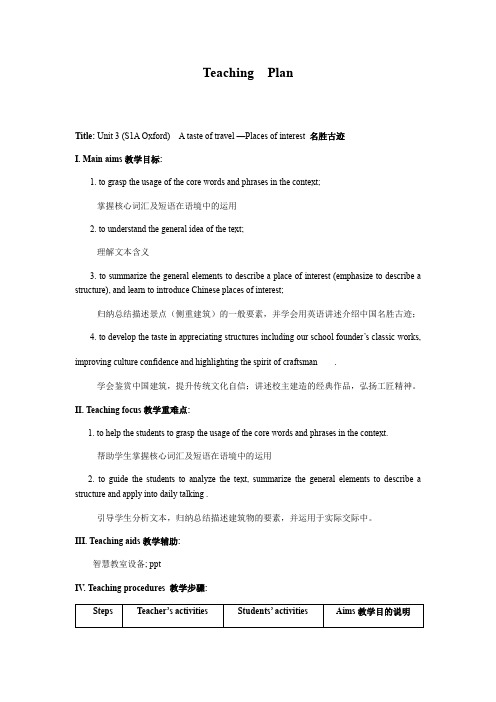
Teaching PlanTitle: Unit 3 (S1A Oxford) A taste of travel —Places of interest 名胜古迹I. Main aims教学目标:1. to grasp the usage of the core words and phrases in the context;掌握核心词汇及短语在语境中的运用2. to understand the general idea of the text;理解文本含义3. to summarize the general elements to describe a place of interest (emphasize to describe a structure), and learn to introduce Chinese places of interest;归纳总结描述景点(侧重建筑)的一般要素,并学会用英语讲述介绍中国名胜古迹;4. to develop the taste in appreciating structures including our school founder’s classic works, improving culture confidence and highlighting the spirit of craftsman.学会鉴赏中国建筑,提升传统文化自信;讲述校主建造的经典作品,弘扬工匠精神。
II. Teaching focus教学重难点:1. to help the students to grasp the usage of the core words and phrases in the context.帮助学生掌握核心词汇及短语在语境中的运用2. to guide the students to analyze the text, summarize the general elements to describe a structure and apply into daily talking .引导学生分析文本,归纳总结描述建筑物的要素,并运用于实际交际中。
上海牛津1A Unit1 Period1教案
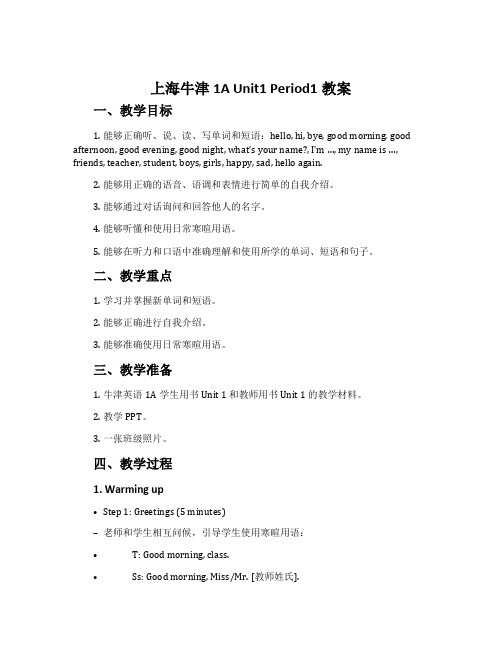
上海牛津1A Unit1 Period1教案一、教学目标1.能够正确听、说、读、写单词和短语:hello, hi, bye, good morning, good afternoon, good evening, good night, what’s your name?, I’m …, my name is …, friends, teacher, student, boys, girls, happy, sad, hello again.2.能够用正确的语音、语调和表情进行简单的自我介绍。
3.能够通过对话询问和回答他人的名字。
4.能够听懂和使用日常寒暄用语。
5.能够在听力和口语中准确理解和使用所学的单词、短语和句子。
二、教学重点1.学习并掌握新单词和短语。
2.能够正确进行自我介绍。
3.能够准确使用日常寒暄用语。
三、教学准备1.牛津英语1A学生用书 Unit 1 和教师用书 Unit 1 的教学材料。
2.教学PPT。
3.一张班级照片。
四、教学过程1. Warming up•Step 1: Greetings (5 minutes)–老师和学生相互问候,引导学生使用寒暄用语:•T: Good morning, class.•Ss: Good morning, Miss/Mr. [教师姓氏].•T: How are you today?•Ss: I’m fine, thank you. And you?•T: I’m fine too. Thank you for asking.2. Pre-task•Step 2: Review words and phrases (10 minutes)–老师通过PPT展示Unit 1单词和短语的图片,引导学生复习和回忆,并帮助其正确读音。
–老师可以进行单词和短语的口头测试,鼓励学生积极参与。
3. While-task•Step 3: Teach new words and phrases (15 minutes)–老师逐个教授新单词和短语,并帮助学生正确发音,理解词义和用法。
上海新教材牛津英语高一上学期英语教案
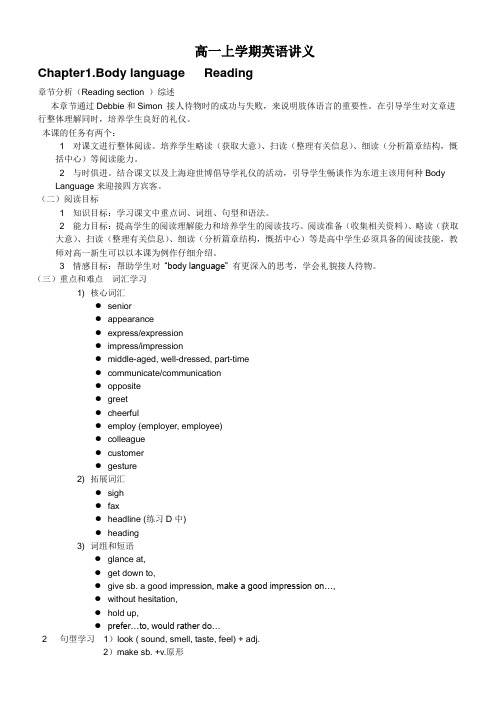
高一上学期英语讲义Chapter1.Body language Reading章节分析(Reading section )综述本章节通过Debbie和Simon 接人待物时的成功与失败,来说明肢体语言的重要性。
在引导学生对文章进行整体理解同时,培养学生良好的礼仪。
本课的任务有两个:1 对课文进行整体阅读。
培养学生略读(获取大意)、扫读(整理有关信息)、细读(分析篇章结构,慨括中心)等阅读能力。
2 与时俱进。
结合课文以及上海迎世博倡导学礼仪的活动,引导学生畅谈作为东道主该用何种BodyLanguage来迎接四方宾客。
(二)阅读目标1 知识目标:学习课文中重点词、词组、句型和语法。
2 能力目标:提高学生的阅读理解能力和培养学生的阅读技巧。
阅读准备(收集相关资料)、略读(获取大意)、扫读(整理有关信息)、细读(分析篇章结构,慨括中心)等是高中学生必须具备的阅读技能,教师对高一新生可以以本课为例作仔细介绍。
3 情感目标:帮助学生对“body language”有更深入的思考,学会礼貌接人待物。
(三)重点和难点词汇学习1) 核心词汇●senior●appearance●express/expression●impress/impression●middle-aged, well-dressed, part-time●communicate/communication●opposite●greet●cheerful●employ (employer, employee)●colleague●customer●gesture2) 拓展词汇●sigh●fax●headline (练习D中)●heading3) 词组和短语●glance at,●get down to,●give sb. a good impressi on, make a good impression on…,●without hesitation,●hold up,●prefer…to, would rather do…2 句型学习1)look ( sound, smell, taste, feel) + adj.2)make sb. +v.原形1介绍高中教材的特点,介绍阅读中skimming 和scanning的含义与技巧.1) What is skimming?Skimming is a reading strategy. When we skim a piece of reading, we read it very quickly inorder to get the general idea of the reading. When we skim, we skip the unimportant parts. Therefore, when we skim, we usually only look at titles and headings, pictures and diagrams, and important sentences (usually the first and last sentences of a paragraph) in the reading. Skimming takes only a minute or two, and it helps us get the general outline of the reading and follow the writer’s idea more easily. It is a way to prepare us for a better and detailed understanding of the writer’s ideas.略读是一种阅读方式。
(完整版)牛津版高一英语必修1全套教案,推荐文档
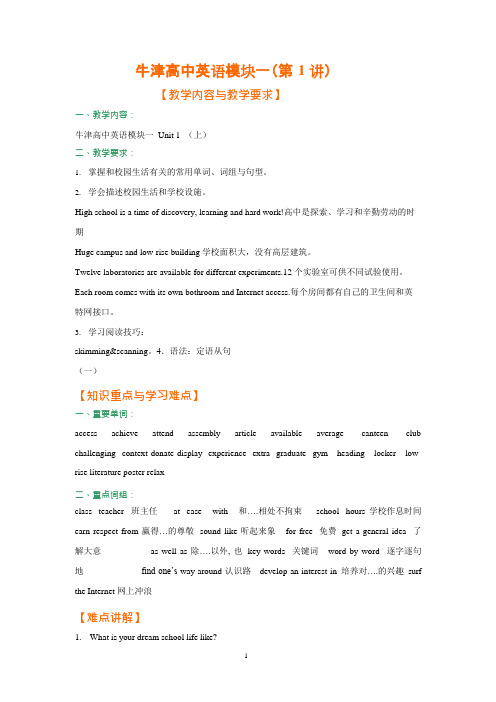
牛津高中英语模块一(第1 讲)【教学内容与教学要求】一、教学内容:牛津高中英语模块一Unit 1 (上)二、教学要求:1.掌握和校园生活有关的常用单词、词组与句型。
2.学会描述校园生活和学校设施。
High school is a time of discovery, learning and hard work!高中是探索、学习和辛勤劳动的时期Huge campus and low-rise building 学校面积大,没有高层建筑。
Twelve laboratories are available for different experiments.12 个实验室可供不同试验使用。
Each room comes with its own bothroom and Internet access.每个房间都有自己的卫生间和英特网接口。
3.学习阅读技巧:skimming&scanning。
4.语法:定语从句(一)【知识重点与学习难点】一、重要单词:access achieve attend assembly article available average canteen club challenging context donate display experience extra graduate gym heading locker low- rise literature poster relax二、重点词组:class teacher 班主任at ease with 和….相处不拘束school hours 学校作息时间earn respect from 赢得…的尊敬sound like 听起来象for free 免费get a general idea 了解大意as well as 除….以外, 也key words 关键词word by word 逐字逐句地find one’s way around 认识路develop an interest in 培养对….的兴趣surf the Internet 网上冲浪【难点讲解】1.What is your dream school life like?你理想中的学校生活是什么样子?这里dream 表示心目中最理想的. 如dream team (梦之队)。
牛津英语高一必修1教案全套

⽜津英语⾼⼀必修1教案全套⽜津⾼中英语模块⼀(第 1 讲)⽜津⾼中英语模块⼀(第五讲)主讲教师:邵磊主审:孙德霖【教学内容与教学要求】⼀、教学内容:⽜津⾼中英语模块⼀Unit 3(上)⼆、教学要求:1.学会谈论健康、锻炼,描述问题。
2.学习e-mail 的写作。
3.语法:⾮限制性定语从句、反意疑问句。
【知识重点与学习难点】⼀、重要单词:stay(系动词:保持),slim, figure, weight, ashamed, recover, failure, contain, chemical, seldom, damage, attractive, touching, embarrassed, pressure, overweight, diet, properly, skinny, con sider, fit(强健的),pill, appeara nee, especially, amazed, archery, squash, aerobics有氧运动),triathlon(铁⼈三项),category, partial(咅E分的),response, purpose, confirmation, actually, recognize.⼆、重点词组:work out 锻炼、训练,go on diets/a diet实⾏节⾷,in secret私⾃,side effect副作⽤,put on weight 体重增⼒⼙,lose weight 减肥,be ashamed of对….感⾄U羞耻,an exact match for和….完全匹配的…,follow one 'advice听从某⼈的建议,sou nd fun 听起来象是件有趣的事,team sport团队运动,build up增强,regret doing sth后悔做了某事, risk doing sth 冒做某事的风险.三、【语法术语】non-restrictive attributive clause ⾮限制性定语从句, question tag 反意疑问句, positive statement 肯定的陈述句, negative statement 否定的陈述句, personal pronoun ⼈称代词,auxiliary verb 助动词,model verb 情态动词,imperative clause 祈使句.【难点讲解】1. What do you do to keep yourself looking good and feeling go?od你是怎样保持⾃⼰良好的外在形象和健康的⾝体状况的?询问别⼈怎样做某事的可以⽤“ how do you…..?”也可以⽤“ what do you do to….?”例如:How did you make the baby stop crying?What did you do to make the baby stop crying?Keep yourself look ing good and feeli ng good 是⼀个“动 + 宾语+ 补语”结构,现在分词短语looking good and feeling good作宾补。
牛津版高一英语必修1全套教案

牛津版高一英语必修1全套教案1. Introduction (介绍)本文档为牛津版高一英语必修1全套教案,旨在帮助教师更好地教授这门课程。
本教案按照教材单元结构编排,包括每个单元的主要话题和语言技能目标,以及教学策略和教学活动建议。
2. Unit 1 Friendship (友谊)2.1 Topic (话题)本单元的主题为友谊,学生将学会如何表达对朋友的欣赏和感激之情,并探讨友谊在人生中的重要性。
2.2 Language skills (语言技能)•提高听力技能,能听懂有关朋友的讨论并发表自己的看法。
•提高口语技能,能准确表达自己对朋友的看法和感激之情。
•提高阅读技能,掌握有关友谊的词汇和短语,以及阅读有关朋友的文章并做出回答。
•提高写作技能,能写一篇有关朋友的短文或书信。
2.3 Teaching strategies (教学策略)为了达到教学目标并顺利完成教学任务,本单元教学应采取以下策略:•提供足够的听说机会,鼓励学生在班级里交流,增加对英语的自信心。
•鼓励学生动手实践,引导他们积极参与活动,提高语言实际运用能力。
•提供真实相关的材料,让学生学习与生活相关的英语,提高学生的兴趣和参与度。
•多元化教学法,如小组讨论、角色扮演、情景编写,提高教学效果。
2.4 Teaching activities (教学活动)1.口语训练 (Speaking Practice)•让学生分组,讨论以下问题:你最好的朋友是谁?你们相遇多久了?你们的共同爱好是什么?你觉得你们的友谊最重要的是什么?•老师可以举例介绍自己的最好的朋友,并与学生分享。
随后,学生练习如何表达自己的看法和感激之情。
•角色扮演:学生分角色,模拟两个朋友相遇的情景,展示他们的探讨过程。
2.听力训练 (Listening Practice)•播放一段与朋友相关的记录,并让学生回答以下问题:记录的主题是什么?有多少个人参与讨论?他们的想法是什么?•展示一段对朋友的感恩视频,让学生听完后讨论其中的感情魅力,分享自己的感受。
牛津上海版高中一年级第一学期Unit5教案

5. Evaluate the argument to find out how Sally is arguing against Sam from the perspective of personal health.
To familiarize the students with the concept of vegetarian while learning the food vocabulary.
2. Skim the rest of the dialogue to work out what Sam and Sally are arguing and highlight the sentences that speak of their points of view.
4. Compare the supporting details iven in the dialogue and ponder from what perspective Sam and Sally built their argument, who is more persuasive and why?
Homework:
1. Read the dialogue again and share with their partner if they find more reasoning and supporting details.
2. Polish the writing on your worksheet.
牛津英语(上海版)高一第一学期Unit 5
上海版牛津英语高一上册教案 unit 3MORE READING—More places to visit
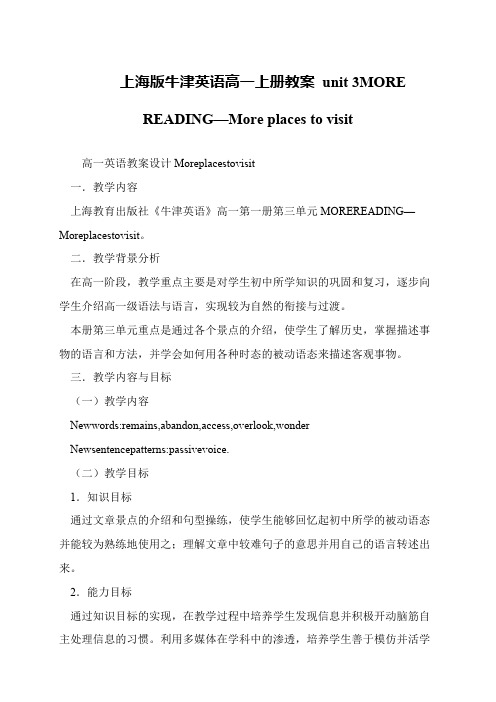
上海版牛津英语高一上册教案unit 3MORE
READING—More places to visit
高一英语教案设计Moreplacestovisit
一.教学内容
上海教育出版社《牛津英语》高一第一册第三单元MOREREADING—Moreplacestovisit。
二.教学背景分析
在高一阶段,教学重点主要是对学生初中所学知识的巩固和复习,逐步向学生介绍高一级语法与语言,实现较为自然的衔接与过渡。
本册第三单元重点是通过各个景点的介绍,使学生了解历史,掌握描述事物的语言和方法,并学会如何用各种时态的被动语态来描述客观事物。
三.教学内容与目标
(一)教学内容
Newwords:remains,abandon,access,overlook,wonder
Newsentencepatterns:passivevoice.
(二)教学目标
1.知识目标
通过文章景点的介绍和句型操练,使学生能够回忆起初中所学的被动语态并能较为熟练地使用之;理解文章中较难句子的意思并用自己的语言转述出来。
2.能力目标
通过知识目标的实现,在教学过程中培养学生发现信息并积极开动脑筋自主处理信息的习惯。
利用多媒体在学科中的渗透,培养学生善于模仿并活学。
上海牛津英语1a教案
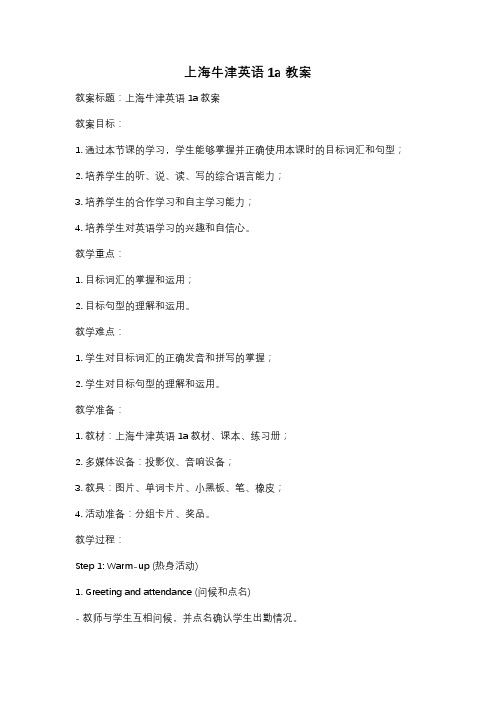
上海牛津英语1a教案教案标题:上海牛津英语1a教案教案目标:1. 通过本节课的学习,学生能够掌握并正确使用本课时的目标词汇和句型;2. 培养学生的听、说、读、写的综合语言能力;3. 培养学生的合作学习和自主学习能力;4. 培养学生对英语学习的兴趣和自信心。
教学重点:1. 目标词汇的掌握和运用;2. 目标句型的理解和运用。
教学难点:1. 学生对目标词汇的正确发音和拼写的掌握;2. 学生对目标句型的理解和运用。
教学准备:1. 教材:上海牛津英语1a教材、课本、练习册;2. 多媒体设备:投影仪、音响设备;3. 教具:图片、单词卡片、小黑板、笔、橡皮;4. 活动准备:分组卡片、奖品。
教学过程:Step 1: Warm-up (热身活动)1. Greeting and attendance (问候和点名)- 教师与学生互相问候,并点名确认学生出勤情况。
2. Sing a song (唱歌)- 教师带领学生唱一首与本课主题相关的英文歌曲,如《Hello, How Are You?》。
Step 2: Presentation (呈现新知)1. Introduce new vocabulary (介绍新词汇)- 教师使用图片或单词卡片依次呈现本课时的目标词汇,如cat, dog, bird, etc.,并帮助学生正确发音和拼写。
2. Practice vocabulary (练习词汇)- 教师与学生一起进行词汇练习,如师生问答、单词拼写比赛等。
3. Introduce target sentence (介绍目标句型)- 教师呈现目标句型,如"What's this? It's a cat.",并通过示范和反复操练帮助学生理解和掌握。
Step 3: Practice (练习)1. Role-play (角色扮演)- 将学生分成小组,每个小组分别扮演不同的角色,用目标句型进行对话练习。
- 1、下载文档前请自行甄别文档内容的完整性,平台不提供额外的编辑、内容补充、找答案等附加服务。
- 2、"仅部分预览"的文档,不可在线预览部分如存在完整性等问题,可反馈申请退款(可完整预览的文档不适用该条件!)。
- 3、如文档侵犯您的权益,请联系客服反馈,我们会尽快为您处理(人工客服工作时间:9:00-18:30)。
高一上学期英语讲义Chapter1.Body language Reading章节分析(Reading section )综述本章节通过Debbie和Simon 接人待物时的成功与失败,来说明肢体语言的重要性。
在引导学生对文章进行整体理解同时,培养学生良好的礼仪。
本课的任务有两个:1 对课文进行整体阅读。
培养学生略读(获取大意)、扫读(整理有关信息)、细读(分析篇章结构,慨括中心)等阅读能力。
2 与时俱进。
结合课文以及上海迎世博倡导学礼仪的活动,引导学生畅谈作为东道主该用何种BodyLanguage来迎接四方宾客。
(二)阅读目标1 知识目标:学习课文中重点词、词组、句型和语法。
2 能力目标:提高学生的阅读理解能力和培养学生的阅读技巧。
阅读准备(收集相关资料)、略读(获取大意)、扫读(整理有关信息)、细读(分析篇章结构,慨括中心)等是高中学生必须具备的阅读技能,教师对高一新生可以以本课为例作仔细介绍。
3 情感目标:帮助学生对“body language”有更深入的思考,学会礼貌接人待物。
(三)重点和难点词汇学习1) 核心词汇●senior●appearance●express/expression●impress/impression●middle-aged, well-dressed, part-time●communicate/communication●opposite●greet●cheerful●employ (employer, employee)●colleague●customer●gesture2) 拓展词汇●sigh●fax●headline (练习D中)●heading3) 词组和短语●glance at,●get down to,●give sb. a good impressi on, make a good impression on…,●without hesitation,●hold up,●prefer…to, would rather do…2 句型学习1)look ( sound, smell, taste, feel) + adj.2)make sb. +v.原形1介绍高中教材的特点,介绍阅读中skimming 和scanning的含义与技巧.1) What is skimming?Skimming is a reading strategy. When we skim a piece of reading, we read it very quickly inorder to get the general idea of the reading. When we skim, we skip the unimportant parts. Therefore, when we skim, we usually only look at titles and headings, pictures and diagrams, and important sentences (usually the first and last sentences of a paragraph) in the reading. Skimming takes only a minute or two, and it helps us get the general outline of the reading and follow the writer’s idea more easily. It is a way to prepare us for a better and detailed understanding of the writer’s ideas.略读是一种阅读方式。
当我们进行阅读时,我们是在非常快速地阅读,目的是获地阅读材料的大概轮廓或意义。
在略读时,我们跳过不重要的部分。
因此,我们通常只看题目和段落标题、附图和图表以及重要的句子(一般是每个段落的第一句和最后一句)。
略读只需一二分钟,它帮助我们获得阅读材料的大概轮廓并使我们更好地跟上作者的思路,它为我们更准确、更仔细的理解作者的思想做好了准备。
2) What is scanning?Scanning is a reading strategy. When we scan a piece of reading, we read it very quickly in order to get specific or single pieces of information. So we scan to get information about time, names, places and numbers, etc. When we scan, we always skip the irrelevant parts and we only focus on what we need to find out.跳读是一种阅读方法。
当我们在扫读一篇阅读材料时,我们是在非常快速地阅读,目的是获得有关时间、姓名、地点和数据等的信息。
在跳读时,我们总是跳过不相关的部分,而只是集中注意我们需要发现的信息。
3)Practice ( 老师们可以用以下材料说明介绍skimming和scanning的阅读技巧。
)English MannersWhen we meet someone we know, the simplest thing to say in English is “Good morning”, “Good afternoon”, or “Good evening”. “Hello” and “Hi” are forms of informal greeting. We avoid using them with seniors or in a very formal situation. “How are you?” and “How are you doing?” are often used to greet friends. They are used either during the day or in the evening. “How do you do?” seems to be used lessoften than before.Some forms of greeting which are good manners in China are not considered so in Britain or some other English-speaking countries. For example, usually we should avoid greeting a foreign friend by saying “ Where are you going?” or “Where have you been?”, which are quite common among friends inChina. If we did ask either of these questions, the foreign friend would think that we were asking about his private affairs. Neither should we greet a foreigner by saying “Have you had your dinner?”. He might think you were inviting him to dinner !These forms of greeting are only acceptable when they are used with close friends.In most English-speaking countries shaking hands is also a form of greeting, and the best kind of handshake is gentle and firm. Close friends or relatives, on the other hand, usually do not shake handswith each other; they often exchange a quick kiss on the cheek when they meet or part. Men, however, don ’t often kiss or embrace when greeting each other.Men still tend to open doors for women in public. However, some young girls cannot stand that. Nowadays more and more women are opening doors for men!Good manners are made up of many small things. Foreign friends or colleagues can get very upset if we forget to say or do something properly. This can be clearly shown through the following example. One day, on the desk of a department office in a college, lay a letter for a visiting Americanprofessor. Her Chinese colleague happened to pass by. She saw it, picked it up, and later gave it to the American professor, saying, “ Mrs Willis, a letter for you from your hometown.” To her surprise, thevisiting professor immediately put on a stiff face. She didn ’t know the reason why the Chinese colleague was interested in her private affairs. At the same time, the Chinese teacher didn ’t know the reason why Mrs Willis took offence.Thus, we have a lot to learn about English manners. The native speakers around us offer very good examples when talking and acting. English books, TV programmes and the Internet provide lessons aswell. Some dictionaries also present lists of common polite expressions. So, we must try our best to learn more about English manners and people ’s ways of life so that we can communicate with foreigners more properly.Exercises:A) Skimming: Read the first and last sentences of each paragraph and match the summaries( answer: a)---E,b)---F, c)---C, d)---D, e)---A, f)---B )(虽然这篇文章很长,但经过skimming 环节,同学们基本能在较短的时间内,通过看每一段落的第一句和最后一句,找到每段的段落大意,理清作者的写作思路,为下一步寻找细节奠定基础。
